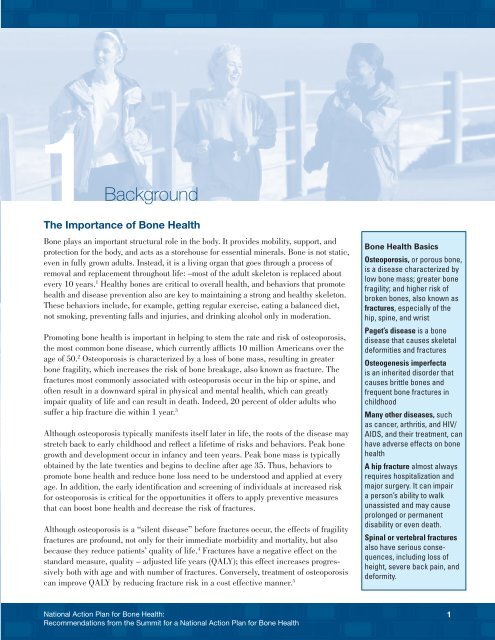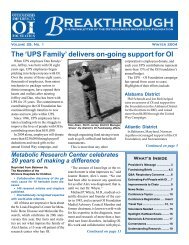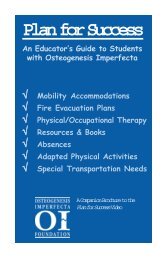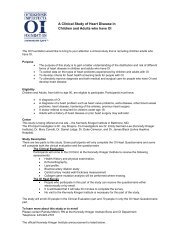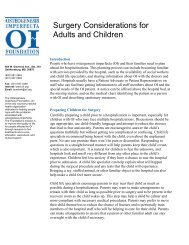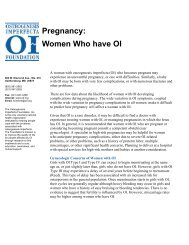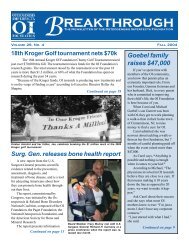National Action Plan for Bone Health - Osteogenesis Imperfecta ...
National Action Plan for Bone Health - Osteogenesis Imperfecta ...
National Action Plan for Bone Health - Osteogenesis Imperfecta ...
You also want an ePaper? Increase the reach of your titles
YUMPU automatically turns print PDFs into web optimized ePapers that Google loves.
1 Background<br />
The Importance of <strong>Bone</strong> <strong>Health</strong><br />
<strong>Bone</strong> plays an important structural role in the body. It provides mobility, support, and<br />
protection <strong>for</strong> the body, and acts as a storehouse <strong>for</strong> essential minerals. <strong>Bone</strong> is not static,<br />
even in fully grown adults. Instead, it is a living organ that goes through a process of<br />
removal and replacement throughout life: –most of the adult skeleton is replaced about<br />
every 10 years. 1 <strong>Health</strong>y bones are critical to overall health, and behaviors that promote<br />
health and disease prevention also are key to maintaining a strong and healthy skeleton.<br />
These behaviors include, <strong>for</strong> example, getting regular exercise, eating a balanced diet,<br />
not smoking, preventing falls and injuries, and drinking alcohol only in moderation.<br />
Promoting bone health is important in helping to stem the rate and risk of osteoporosis,<br />
the most common bone disease, which currently afflicts 10 million Americans over the<br />
age of 50. 2 Osteoporosis is characterized by a loss of bone mass, resulting in greater<br />
bone fragility, which increases the risk of bone breakage, also known as fracture. The<br />
fractures most commonly associated with osteoporosis occur in the hip or spine, and<br />
often result in a downward spiral in physical and mental health, which can greatly<br />
impair quality of life and can result in death. Indeed, 20 percent of older adults who<br />
suffer a hip fracture die within 1 year. 3<br />
Although osteoporosis typically manifests itself later in life, the roots of the disease may<br />
stretch back to early childhood and reflect a lifetime of risks and behaviors. Peak bone<br />
growth and development occur in infancy and teen years. Peak bone mass is typically<br />
obtained by the late twenties and begins to decline after age 35. Thus, behaviors to<br />
promote bone health and reduce bone loss need to be understood and applied at every<br />
age. In addition, the early identification and screening of individuals at increased risk<br />
<strong>for</strong> osteoporosis is critical <strong>for</strong> the opportunities it offers to apply preventive measures<br />
that can boost bone health and decrease the risk of fractures.<br />
Although osteoporosis is a “silent disease” be<strong>for</strong>e fractures occur, the effects of fragility<br />
fractures are profound, not only <strong>for</strong> their immediate morbidity and mortality, but also<br />
because they reduce patients’ quality of life. 4 Fractures have a negative effect on the<br />
standard measure, quality – adjusted life years (QALY); this effect increases progressively<br />
both with age and with number of fractures. Conversely, treatment of osteoporosis<br />
can improve QALY by reducing fracture risk in a cost effective manner. 5<br />
<strong>Bone</strong> <strong>Health</strong> Basics<br />
Osteoporosis, or porous bone,<br />
is a disease characterized by<br />
low bone mass; greater bone<br />
fragility; and higher risk of<br />
broken bones, also known as<br />
fractures, especially of the<br />
hip, spine, and wrist<br />
Paget’s disease is a bone<br />
disease that causes skeletal<br />
de<strong>for</strong>mities and fractures<br />
<strong>Osteogenesis</strong> imperfecta<br />
is an inherited disorder that<br />
causes brittle bones and<br />
frequent bone fractures in<br />
childhood<br />
Many other diseases, such<br />
as cancer, arthritis, and HIV/<br />
AIDS, and their treatment, can<br />
have adverse effects on bone<br />
health<br />
A hip fracture almost always<br />
requires hospitalization and<br />
major surgery. It can impair<br />
a person’s ability to walk<br />
unassisted and may cause<br />
prolonged or permanent<br />
disability or even death.<br />
Spinal or vertebral fractures<br />
also have serious consequences,<br />
including loss of<br />
height, severe back pain, and<br />
de<strong>for</strong>mity.<br />
<strong>National</strong> <strong>Action</strong> <strong>Plan</strong> <strong>for</strong> <strong>Bone</strong> <strong>Health</strong>:<br />
Recommendations from the Summit <strong>for</strong> a <strong>National</strong> <strong>Action</strong> <strong>Plan</strong> <strong>for</strong> <strong>Bone</strong> <strong>Health</strong><br />
1


